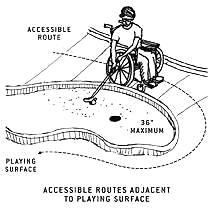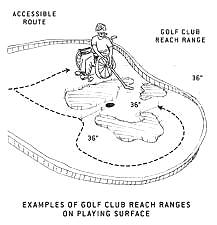 In New Jersey not long ago, I went to play miniature golf with my fiance. I’ll call the place “Golfville.” After we’d paid, we discovered that the course consisted of nothing but flat, straight, unchallenging par-2 holes. I immediately complained to the management, and the response was that a NJ law requires any new miniature golf course to be wheelchair accessible!
In New Jersey not long ago, I went to play miniature golf with my fiance. I’ll call the place “Golfville.” After we’d paid, we discovered that the course consisted of nothing but flat, straight, unchallenging par-2 holes. I immediately complained to the management, and the response was that a NJ law requires any new miniature golf course to be wheelchair accessible!
In other words, I mused, only crappy miniature golf courses can now be built – which means no one who isn’t handicapped will want to play, effectively killing the pastime – just so a handful of theoretical miniature golf “diehards on wheelchairs” can play. Sounded pretty stupid. (BTW, we didn’t even bother playing, and they wouldn’t give me a refund.)
An online search of NJ statutes turned up nothing about miniature golf courses, so I assumed the proprietor of “Golfville” was simply a big, fat prevaricator. Not so, as it happens, for the actual perpetrator of such idiocy is – you guessed it – the big, fat federal government.
 Specifically, the Architectural and Transportation Barriers Compliance Board (an Orwellian moniker if ever there was one) issued a “final rule” in 2002 that “amends ADAAG (Americans with Disabilities Act Accessibility Guidelines) by adding a new “special application section for amusement rides, boating facilities, fishing piers and platforms, golf courses, miniature golf, sports facilities, and swimming pools and spas.” Just what the nation needed.
Specifically, the Architectural and Transportation Barriers Compliance Board (an Orwellian moniker if ever there was one) issued a “final rule” in 2002 that “amends ADAAG (Americans with Disabilities Act Accessibility Guidelines) by adding a new “special application section for amusement rides, boating facilities, fishing piers and platforms, golf courses, miniature golf, sports facilities, and swimming pools and spas.” Just what the nation needed.
I invite readers to peruse this overstuffed 90-page document. It provides guidance to entrepreneurs on everything from “Multiple Chemical Sensitivities and Electromagnetic Sensitivities” to “Shoulder-to-Shoulder Seating” on amusement rides. It’s hard to believe how much time and money was obviously spent on micro-managing every aspect of recreation which might be applicable to the disabled.
An email to the aforementioned Compliance Board produced a response that “The Department of Justice (DOJ) has not yet adopted the ADA Accessibility Guidelines for Miniature Golf Courses as the enforceable standard…. It is likely for this process to take a couple of years to be completed…. They will become the standard in the future.” So the time to get your mini-golf ya-yas out is now.
The miniature golf regulations can be found at Accessible Rout. They apply to newly-constructed and altered courses – which allows plenty of leeway for forcing owners who want to renovate a hole or two to re-do the whole shebang. The operator of “Golfville” had it wrong, though – only half of the holes have to be accessible. According to the guidelines, the holes must be consecutive, to offer a “more socially integrated experience.”
There are plenty of other nit-picking rules (and illustrations); for example:
“There is usually a curb around a hole to keep the ball within the area. When the accessible route is provided on the course, a 1-inch high maximum curb is permitted for an opening of 32 inches minimum where the accessible route extends outside the hole. This opening will permit passage of wheelchairs, while containing the ball within the hole. Designers should consider locating this opening in an area where the ball is not likely to roll. The accessible route on a playing surface must be within 36 inches (the golf club reach range) of any area where the ball comes to rest.”
“Landings must be 48 inches long. Where ramps change direction, the landing size must be a minimum of 48 inches by 60 inches. The orientation of the length and the width have not been specified for added flexibility in design. Slopes on landings must be no more than 1:20 (5%). If the accessible route is on the playing surface, handrails are not required. The accessible route may include a maximum slope of 1:4 (25%) for a maximum 4-inch rise. These steeper slopes or ramps are permitted for limited distances.”
I understand the desire to include the disabled in recreational activities, and this is not a bad idea. (I’m sure that if I were wheelchair-bound I’d be complaining about all the things I couldn’t do and all the places I couldn’t go. Would I have the right, however, to demand access to everywhere I feel like going?) What I don’t understand is that the federal government has any business telling mini-golf entrepreneurs what they can and can’t do with their own property, that it can define what a “socially integrated experience” is, and then it can force all of this down everyone’s throat in order to include a small minority which may or may not have any interest in the activity in the first place.
 If there were, in fact, a demand for wheelchair-accessible mini-golf courses, wouldn’t businesspeople be building them? The disabled from miles and miles around would descend like locusts upon such places, and their owners would make fortunes! Forced compliance would be unnecessary if the need actually existed.
If there were, in fact, a demand for wheelchair-accessible mini-golf courses, wouldn’t businesspeople be building them? The disabled from miles and miles around would descend like locusts upon such places, and their owners would make fortunes! Forced compliance would be unnecessary if the need actually existed.
So, as old mini-golf courses wear out and new ones are built, nine holes out of eighteen will be tepid at best, effectively killing the fun for the non-disabled 99% of players. An alternative would be to build two courses, one for the disabled and one for the non-disabled. Twice as expensive to build, but too bad for the entrepreneur…. Of course, all of this will really improve people’s attitudes toward the handicapped.
July 27, 2005
Andrew S. Fischer has worked in various fields.



